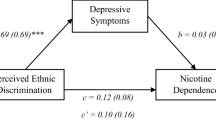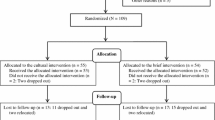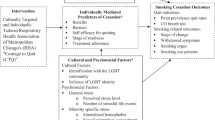Abtract
The aim of the current study was to identify the role of psychological characteristics of treatment-seeking smokers and examine their role in cessation outcomes. Participants were 750 Greek Caucasian smokers who were self-referred to a Smoking Cessation Clinic. Data on smoking and psychological assessment was obtained from the Fagerström Test for Nicotine Dependence, the Self-Rating Zung Depression Scale, the Health Locus of Control Scale, and the State-Trait Anxiety Inventory. Smoking status was made by self-report and abstinence was defined as “not a single puff of smoke during the last week”. The self-reported abstinence rate at 6 months was 33.7 % versus 9.4 % at 12-month follow-up. Chi-square tests revealed associations between psychological baseline characteristics and smoking status at follow-up. In particular, abstinence at one-year follow-up was associated with gender, increasing the odds of abstinence for female smokers by about 5 times, abstinence was associated with past quit attempts, self-confidence in quitting, and health reasons for quitting. A stepwise modeling procedure indicated past quit attempts, current life satisfaction, and I-internal health locus of control as the main independent predictors of smoking cessation. Findings provide useful information on the unique cultural norms and social influences of Greek smokers and suggest the urgent need in primary care settings to address psychological characteristics along with cultural differences in order to change the smoking culture and achieve successful smoking cessation outcomes. Future research should target psychological and cultural characteristics as key treatment components in smoking cessation.
Similar content being viewed by others
References
American Psychiatric Association. (2000). Diagnostic and statistical manual of mental disorders (4th ed.). Washington: American Psychiatric Publishing.
Anda, R. F., Williamson, D. F., Escobedo, L. G., Mast, E. E., Giovino, G. A., & Remington, P. L. (1990). Depression and the dynamics of smoking: a national perspective. Journal of the American Medical Association, 264, 1541–1545.
Aubin, H. J., Lebargy, F., Berlin, I., Bidaut-Mazel, C., Chemali-Hudry, J., & Lagrue, G. (2004). Efficacy of bupropion and predictors of successful outcome in a sample of French smokers: a randomized placebo-controlled trial. Addiction, 99, 1206–1218.
Bandura, A. (1997). Self-efficacy: The exercise of control. New York: Freeman.
Birmpili, E., Katsiki, N., Malhotra, A., Dimopoulou, E., Mikhailidis, D. P., & Tsiligiroglou-Fachantidou, A. (2012). Gender and socio-economic differences in daily smoking and smoking cessation among adult residents in a Greek rural area. Open Cardiovascular Medicine Journal, 6, 15–21.
Bjornson, W., Rand, C., Connett, J. E., Lindgren, P., Nides, M., Pope, F., Buist, A. S., Hoppe-Ryan, C., & O'Hara, P. (1995). Gender differences in smoking cessation after three years in the lung health study. American Journal of Public Health, 85, 223–230.
Brown, R. A., Kahler, C. W., Niaura, R., Abrams, D. B., Sales, S. D., Ramsey, S. E., Goldstein, M. G., Burgess, E. S., & Miller, I. W. (2001). Cognitive-behavioral treatment for depression in smoking cessation. Journal of Consulting and Clinical Psychology, 69, 471–480.
Caleyachetty, A., Lewis, S., McNeill, A., & Leonardi-Bee, J. (2012). Struggling to make ends meet: exploring pathways to understand why smokers in financial difficulties are less likely to quit successfully. European Journal of Public Health, 22, 41–48.
Cattell, R.B., & Kline, P. (1977). The Scientific Analysis of Personality and Motivation. London.
Chatkin, J. M, Abreu, C. M, Haggstram, F. M, Blanco, D. C, Rodini, V., … Martins, D. (2002). Exhaled CO: is 10 ppm a reliable threshold value to confirm current smoking? American Journal of Respiratory Critical Care Medicine, 165, 19 s.
Cinciripini, P. M., Wetter, D. W., Fouladi, R. T., Blalock, J. A., Carter, B. L., Cinciripini, L. G., & Baile, W. F. (2003). The effects of depressed mood on smoking cessation: mediation by post-cessation self-efficacy. Journal of Consulting and Clinical Psychology, 71, 292–301.
Cohen, S., & Wills, T. A. (1985). Stress, social support, and the buffering hypothesis. Psychological Bulletin, 98(2), 310–357. doi:10.1037/0033-2909.98.2.310.
Covey, L. S. (2004). Comments on ‘history of depression and smoking cessation outcome: a meta-analysis. Nicotine & Tobacco Research, 6, 743–745.
Covey, L.S., Bomback, A., & Yan, G. W. (2006). History of depression and smoking cessation: a rejoinder. Nicotine Tobacco Research, 8(2), 315–319.
Crowne, D. P., & Marlowe, D. (1960). A new scale of social desirability independent of psychopathology. Journal of Consulting Psychology, 24(4), 349–354. doi:10.1037/h0047358.
DeJonghe, J., & Baneke, J. (1989). The Zung self-rating depression scale: a replication study on reliability, validity and prediction. Psychological Reports, 64, 833–834.
Deveci, S. E., Deveci, F., Acik, Y., & Ozan, A. T. (2004). The measurement of exhaled carbon monoxide in healthy smokers and non-smokers. Respiratory Medicine, 98, 551–556.
Dijkstra, A., & Tromp, D. (2002). Is the FTND a measure of physical as well as psychological tobacco dependence? Journal of Substance Abuse Treatment, 23, 367–374.
Etter, J. F., Duc, T. V., & Perneger, T. V. (1999). Validity of the Fagerström test for nicotine dependence and of the heaviness of smoking index among relatively light smokers. Addiction, 94(2), 269–281.
Etter, J. F., Prokhorov, A. V., & Perneger, T. V. (2002). Gender differences in the psychological determinants of cigarette smoking. Addiction, 97, 733–743.
Eurobarometer Special 385. (2012). Attitudes of European Toward Tobacco. Retrieved from http://ec.europa.eu/health/tobacco/docs/eurobaro_attitudes_towards_tobacco_2012_en.pdf
Everitt, B. (1980). Cluster analysis. London: Heinemann Educational Books.
Fagerström, K. O. (1978). Measuring degree of physical dependence to tobacco smoking with reference to individualization of treatment. Addictive Behaviors, 3, 235–241.
Filippidis, F. T., Vardavas, C. I., Loukopoulou, A., Behrakis, P., Connolly, G. N., & Tountas, Y. (2012). Prevalence and determinants of tobacco use among adults in Greece: 4 year trends. European Journal of Public Health, 1–5. doi: 10.1093/eurpub/cks148.
Fountoulakis, K. N., Iacovides, A., & Samolis, S. (2001). Reliability, validity and psychometric properties of the Greek translation of the Zung depression rating scale. BioMedCentral Psychiatry, 1(6), 1–8. doi:10.1186/1471-244.
Ginsberg, D., Hall, S. M., Reus, V. I., & Muñoz, R. F. (1995). Mood and depression diagnosis in smoking cessation. Experimental and Clinical Psychopharmacology, 3, 389–395.
Haas, A. L., Muñoz, R. F., Humfleet, G. L., Reus, V. I., & Hall, S. M. (2004). Influences of mood, depression history, and treatment modality on outcomes in smoking cessation. Journal of Consulting and Clinical Psychology, 72, 563–570.
Hall, S. M. (2004). History of depression and smoking cessation outcome: a meta-analysis: the covey-hitsman exchange. Nicotine & Tobacco Research, 6, 751–752.
Heatherton, F., Kozlowski, L. T., & Fagertrom, K. O. (1991). The fagerstrom test for nicotine dependence (FTND). British Journal of Addictions, 86, 1119–1127.
Hitsman, B., Borrelli, B., McChargue, D. E., Spring, B., & Niaura, R. (2003). History of depression and smoking cessation outcome: a meta-analysis. Journal of Consulting and Clinical Psychology, 71(4), 657–663.
Holt, C. H., Clark, E. M., Kreuter, M. W., & Scharff, D. P. (2000). Does locus of control moderate the effect of tailored health education materials? Health Education Research, 15(4), 393–403.
Hosmer, D. W., Hosmer, T., LeCessie, S., & Lemeshow, S. (1997). A comparison of goodness-of-fit tests for the logistic regression model. Statistics in Medicine, 16, 965–980.
Huang, C. L., Lin, H. H., & Wang, H. H. (2006). The psychometric properties of the Chinese version of the Fagerstrom test for nicotine dependence. Addictive Behaviors, 31(12), 2324–2327.
Hughes, J. R., Giovino, G. A., Klevens, R. M., & Fiore, M. C. (1997). Assessing the generalizability of smoking studies. Addiction, 92, 469–472.
Hughes, J. R., Keely, J. P., Niaura, R. S., Ossip-Klein, D. J., Richmond, R. L., & Swan, G. E. (2003). Measures of abstinence in clinical trials: issues and recommendations. Nicotine Tobacco Research, 5, 603.
Hughes, J. R., Keely, J. P., & Naud, S. (2004). Shape of the relapse curve and long-term abstinence among untreated smokers. Addiction, 99, 29–38.
Hyland, A., Borland, R., Li, Q., Yong, H.-H., McNeill, A., Fong, G. T., O'Connor, R. J., & Cummings, K. M. (2006). Individual-level predictors of cessation behaviours among participants in the international tobacco control (ITC) four country survey. Tobacco Control, 15, 83–94.
Innamorati, M., Lelli, M., Aiello, S., Di Lorenzo Del Casale, F. L., Russo, S., & Ferrari, V. (2006). Validazione convergente e discriminante della versione italiana della Zung self-rating depression scale [convergent and discriminant validation of the Italian version of the Zung self-rating depression scale]. Psicoterapia Cognitiva e Comportamentale, 12, 343–353.
Jarvis, M. J., Cohen, J. E., Delnevo, C. D., & Giovino, G. A. (2013). Dispelling myths about gender differences in smoking cessation: population data from the United States, Canada and Britain. Tobacco Control, 22(5), 356–360. doi:10.1136/tobaccocontrol-2011-050279.
Javors, M. A., Hatch, J. P., & Lamb, R. J. (2005). Cut-off levels for breath carbon monoxide as a marker for cigarette smoking. Addiction, 100, 159–167.
John, U., Meyer, C., Hapke, U., Rumpf, H. J., & Schumann, A. (2004). Nicotine dependence, quit attempts, and quitting among smokers in a regional population sample from a country with a high prevalence of tobacco smoking. Preventive Medicine, 38(3), 350–358.
Kahler, C. W., Spillane, N. S., Day, A., Clerkin, E. M., Parks, A., Leventhal, A. M., & Brown, R. A. (2014). Positive psychotherapy for smoking cessation: treatment development, feasibility, and preliminary results. The Journal of Positive Psychology, 9(1), 19–29. doi:10.1080/17439760.2013.826716.
Killen, J. D., Fortmann, S. P., Davis, L., Strausberg, L., & Varady, A. (1999). Do heavy smokers benefit from higher dose nicotine patch therapy? Experimental and Clinical Psychopharmacology, 7, 226–233.
Kinnunen, T., Doherty, K., Militello, F. S., & Garvey, A. J. (1996). Depression and smoking cessation: characteristics of depressed smokers and effects of nicotine replacement. Journal of Consulting and Clinical Psychology, 64, 791–798.
Kotz, D., Brown, J., & West, R. (2014). Effectiveness of varenicline versus nicotine replacement therapy for smoking cessation with minimal professional support: evidence from an English population study. Psychopharmacology, 231(4), 37–42.
Leventhal, A. M., Ramsey, S. E., Brown, R. A., LaChance, H. R., & Kahler, C. W. (2008). Dimensions of depressive symptoms and smoking cessation. Nicotine & Tobacco Research, 10, 507–517.
McDermott, M. S., Marteau, T. M., Hollands, G. J., Hankins, M., & Aveyard, P. (2013). Change in anxiety following successful and unsuccessful attempts at smoking cessation: cohort study. British Journal of Psychiatry, 202, 62–67.
Monsó, E., Campbell, J., Tønnesen, P., Gustavsson, G., & Morera, J. (2001). Sociodemographic predictors of success in smoking intervention. Tobacco Control, 10, 165–169.
Murray, R. P., Gerald, L. B., Lindgren, P. G., Connett, J. E., Rand, C. S., & Anthonisen, N. R. (2000). Characteristics of participants who stop smoking and sustain abstinence for 1 and 5 years in the Lung Health Study. Preventive Medicine, 30, 392–400.
Niaura, R., Britt, D. M., Shadel, W. G., Goldstein, M., Abrams, D., & Brown, R. (2001). Symptoms of depression and survival experience among three samples of smokers trying to quit. Psychology of Addictive Behaviors, 15, 13–17.
Nides, M. (2008). Update on pharmacologic options for smoking cessation treatment. American Journal of Medicine, 121, S20–S31. doi:10.1016/j.amjmed.2008.01.016.
Norman, G. J., Velicer, W. F., Fava, J. L., & Prochaska, J. O. (2000). Cluster subtypes within stage of change in a representative sample of smokers. Addictive Behaviors, 25, 183–204.
Patrick, D. L., Cheadle, A., Thompson, D. C., Diehr, P., Koepsell, T., & Kine, S. (1994). The validity of self-reported smoking: a review and meta-analysis. American Journal of Public Health, 84, 1086–1093.
Perkins, K. A. (2001). Smoking cessation in women. Special considerations. CNS Drugs, 15, 391–411.
Perneger, T. V. (1998). What’s wrong with Bonferroni adjustements? British Medical Journal, 316(7139), 1236–1238.
Pimenta, F., Leal, I., & Maroco, J. (2008). Health beliefs, stages of change and smoking behaviour in Portuguese college students. Journal of Smoking Cessation, 3(1), 14–22.
Piper, M. E., Kenford, S., Fiore, M. C., & Baker, T. B. (2012). S. Annals of Behavioral Medicine, 43(2), 262–270.
Pomerleau, C. S., Carton, S. M., Lutzke, M. L., Flessland, K. A., & Pomerleau, O. F. (1994). Reliability of the fagerström tolerance questionnaire and the fagerström test for nicotine dependence. Addictive Behaviors, 19, 33–39.
Pomerleau, C. S., Marks, J. L., & Pomerleau, O. F. (2000). Who gets what symptom? Effects of psychiatric cofactors and nicotine dependence on patterns of smoking withdrawal symptomatology. Nicotine Tobacco Research, 2, 275–280.
Prochaska, J., DiClemente, C. C., & Norcross, J. C. (1992). In search of how people change: applications to addictive behaviors. American Psychologist, 47(9), 1102–1114.
Radzius, A., Gallo, J. J., Epstein, D. H., Gorelick, D. A., Cadet, J. L., Uhl, G. E., & Moolchan, E. T. (2003). A factor analysis of the Fagerström test for nicotine dependence (FTND). Nicotine Tobacco Research, 5(2), 255–240.
Rausch, J. L., Nichinson, B., Lamke, C., & Matloff, J. (1990). Influence of negative affect on smoking cessation treatment outcome: a pilot study. British Journal of Addiction, 85, 929–933.
Robert, W. (2006). Defining and assessing nicotine dependence in humans. In J. G. Gregory (Ed.), Understanding nicotine and tobacco addiction (pp. 36–58). Hoboken: Wiley.
Rotter, J. Β. (1966). Generalized expectancies for internal versus external control of reinforcement. Psychological Monographs, 80, 1–28.
Senore, C., Battista, R. N., Shapiro, S. H., Segnan, N., Ponti, A., Rosso, S., & Aimar, D. (1998). Predictors of smoking cessation following physicians’ counselling. Preventive Medicine, 27, 412–421.
Shiffman, S. (1979). The tobacco withdrawal syndrome. In N. A. Kraesnegor (Eds). Cigarette smoking, a dependence process. NIDA Research Monograph, 23, 158–184. Rockville, MD: US Department of Health, Education, and Welfare.
Sichletidis, L. T., Chloros, D., Tsiotsios, I., & Kaouri, S. (2006). High prevalence of smoking in Northern Greece. Primary Care Respiratory Journal, 15, 92–97.
Spielberger, C. D. (1983). Manual for the state-trait anxiety inventory. Pao Alto: Consulting Psychologists Press.
Spielberger, C. D., Jacobs, G. A., Russell, S., & Crane, R. S. (1983). Assessment of anger: The state-trait anger scale. In J. N. Butcher & C. D. Spielberger (Eds.), Advances in personality assessment, 2. Hillsdale: Lawrence Erlbaum Associates.
Stead, L. F., Perera, R., Bullen, C., Mant, D., Hartmann-Boyce, J., Cahill, K., & Lancaster, T. (2012). Nicotine Replacement Therapy for smoking cessation. Cochrane Database of Systematic Reviews, 11. Doi: 10.1002/14651858.CD000146.pub4.
Strickland, B. R. (1978). Internal-external expectancies and health-related behaviors. Journal of Consulting & Clinical Psychology, 46(6), 1192–1211.
Stuart, K., Borland, R., & McMurray, N. (1994). Self-efficacy, health locus of control, and smoking cessation. Addiction, 19(1), 1–12.
Thun, M. J., & DaCosta e Silva, V. L. (2003). Introduction and overview of global tobacco surveillance. In O. Shafey, S. Dolwick, & G. E. Guindon (Eds). Tobacco Control County Profiles. American Cancer Society, World Health Organization and International Union Against Cancer.
Thurber, S., Snow, M., & Honts, C. (2002). The Zung self-rating depression scale: convergent validity and diagnostic discrimination. Assessment, 9(4), 401–405.
Vardavas, C. I., & Kafatos, A. G. (2007). Smoking policy and prevalence in Greece: an overview. European Journal of Public Health, 17(2), 211–213.
Vàzquez, F. L., & Becoña, E. (1999). Depression and smoking in a smoking cessation programme. Journal of Affective Disorders, 55, 125–132.
Vink, J. M., Willemsen, G., Beem, A. L., & Boomsma, D. I. (2005). The Fagerström test for nicotine dependence in a Dutch sample of daily smokers and ex-smokers. Addictive Behaviors, 30(3), 575–579.
Wallston, K. A., Kaplan, G. D., & Maides, S. A. (1976). Development and validation of the health locus of control scale (HLS). Journal of Consulting & Clinical Psychology, 44, 580–585.
Weiss, G. L., & Larsen, D. L. (1990). Health value, health locus of control, and the prediction of health protective behaviors. Social Behavior and Personality: An International Journal, 18(1), 121–135.
West, R., McEwen, A., Bolling, K., & Owen, L. (2001). Smoking cessation and smoking patterns in the general population: a 1-year follow-up. Addiction, 96, 891–902.
Williams-Piehota, P., Schneider, T. R., Pizarro, J., Mowad, L., & Salovey, P. (2004). Matching health messages to health locus of control beliefs for promoting mammography utilization. Psychology and Health, 19(4), 407–423.
World Health Organization. (2013). Tobacco Free Initiative. Retrieved from http://www.who.int/tobacco/mpower/en/
Zvolensky, M. J., Vujanovic, A. A., Miller, M. O., Bernstein, A., Yartz, A. R., Gregor, K. L., & Gibson, L. E. (2007). Incremental validity of anxiety sensitivity in terms of motivation to quit, reasons for quitting, and barriers to quitting among community-recruited daily smokers. Nicotine Tobacco Research, 9(9), 965–975.
Author information
Authors and Affiliations
Corresponding author
Rights and permissions
About this article
Cite this article
Stefanidou, A., Bouros, D., Livaditis, M. et al. Psychological Characteristics and Smoking Cessation Outcomes in a Sample of Greek Smokers. Curr Psychol 34, 66–81 (2015). https://doi.org/10.1007/s12144-014-9241-6
Published:
Issue Date:
DOI: https://doi.org/10.1007/s12144-014-9241-6




